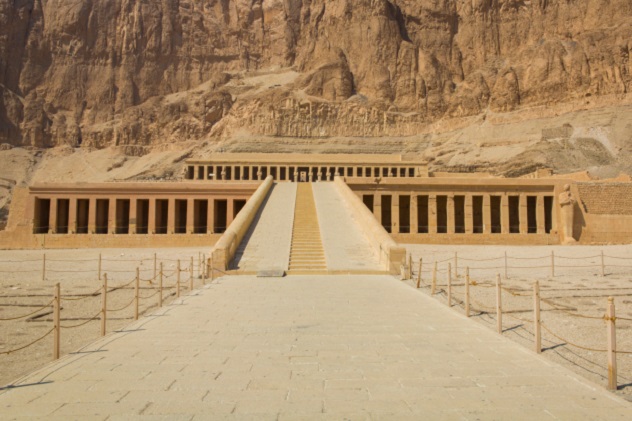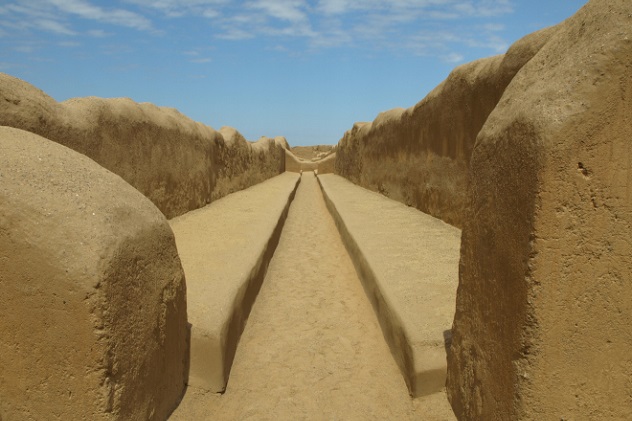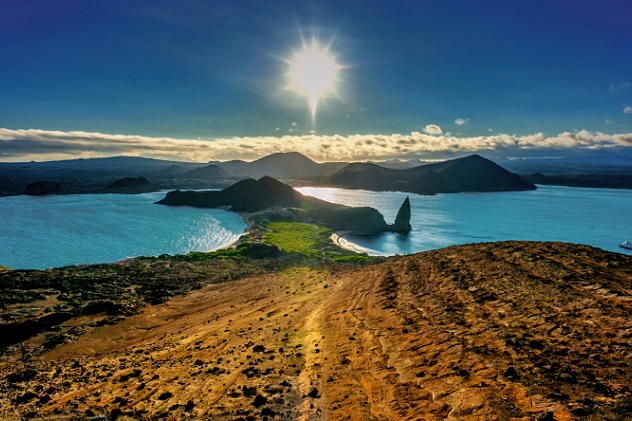Some of the greatest wonders of the world are historical monuments that have existed for hundreds, sometimes thousands of years. Many of them were lost to human knowledge for centuries before they were discovered. However, due to urbanization, natural disasters, and pollution, these historical monuments will likely be lost again before the end of this century.
11. Glacier National Park

About 10,000 years ago, the ice in Montana's Glacier National Park region was about 1.6 km (1 mile) thick. When the park was founded in 1910, it had about 150 glaciers. Only 25 of these giants remain, and it is suspected that they could all be gone by 2030.
The heart of the national park, Grinnell Glacier, has lost more than 90 percent of its ice in the last century. Unsurprisingly, global warming is to blame, but the park appears to have suffered even more than other places: Temperatures in the area have risen 1.8 times more than in other parts of the world.
It’s not just the glaciers that are at risk of disappearing. The icy streams that have always flowed from the vast ice sheets support the park’s ecosystem, with its wolves, herds of elk, and one of the largest populations of grizzly bears in Lower America. If the glaciers disappear, not only will the last vestiges of the Ice Age be gone, but several species will find a home in the ruins.
10. Valley of the Kings

The resting places of Egypt's mighty pharaohs, such as Ramses II and the boy king Tutankhamun, have inspired wonder and awe for centuries. Unfortunately, they have also inspired many treasure hunters who were nothing more than thieves and robbers.
But now the Valley of the Kings faces a different kind of threat. It's not greedy Indiana Jones wannabes, but a few thousand well-meaning tourists. Fungus has begun to grow out of control around the tombs, and scientists believe the parasite thrived because of poor ventilation and the breathing of thousands of visitors. Egypt's head of antiquities has said the tombs could disappear within 150 years.
The engravings and paintings inside the tombs are already beginning to disappear. In response, the number of tourists allowed inside the tombs has been limited, and some exhibits have been completely covered. Hopefully, these restrictions, along with the use of new ventilation systems in the tombs, will be enough to save them.
9. Seychelles

It’s probably a fair bet that most people haven’t heard of the Seychelles, a group of about 115 islands off the coast of the better-known Madagascar. Somehow, they were completely uninhabited by humans until the British East India Company discovered them in the 1600s. After that, they became a haven for pirates. Today, they’re known as one of the best places to see the biggest fish in the sea: whale sharks. The Seychelles hold some of the earliest scientific records of the magnificent creatures, which are strictly protected.
But the islands could be underwater in just half a century, largely due to the destruction of coral barriers around the beaches. The Seychelles have been the victims of one of the world’s worst coral bleaching events. Rising temperatures are eroding corals and leaving them an alarming, almost skeletal white, destroying entire ecosystems and leaving anyone living on the islands vulnerable to devastating events like hurricanes.
8. Olympia

When we think of Ancient Greece, most of us think of the Greek gods, Sparta, or the Olympic Games. While everyone knows that the Olympic Games were created in Greece, few people know exactly which city they were founded in.
Over the years, Olympia was occupied by several different cults that worshiped several different gods, from Cronus, king of the Titans, to Aphrodite, the goddess of lust and beauty. Eventually, one cult claimed the city entirely for its god, the ruler of the Olympians, Zeus himself. Almost everything in the city was created in his honor, from the magnificent 13-meter (42 ft) statue covered in gold and ivory (which, sadly, no longer exists) to the Olympic Games themselves. Today, the Olympic flame is still lit in this city and then transported to where the games are held.
Ironically, it is fire that is threatening the place where the beloved games originated. In 2007, several fires set by arsonists quickly spread across the country, killing more than 60 people. The blaze was barely contained by a dedicated fire brigade, just a hillside away from destroying the historic site of the original games. Thanks to global warming, the fires have become far more frequent and far more powerful, threatening to burn the site to the ground and ruin all efforts to protect it.
7. Chan Chan Archaeological Zone

Chan Chan, which holds the title of the largest pre-Columbian city ever discovered and the largest adobe city ever to exist, covers about 20 kilometres (12 mi) of Peruvian land. It was originally inhabited by the Chimu people, who divided the city into nine different citadels, each of which was autonomous.
Chan Chan has also been called by anthropologists "the first true engineering society in the New World." Their projects, such as an irrigation system that supplied water to the entire city and their attempt to create a massive canal that would extend to the Chicama River 80 kilometers (50 mi) to the north, were unheard of in "civilized" Europe. The city lasted for over 600 years before the Inca Empire finally managed to overthrow it.
Today, this archaeological wonder is under attack not only by those who come to loot and plunder, but also by storms caused by the deadly El Niño phenomenon. Worse, powerful earthquakes have put the city at risk of total destruction.
6. Galapagos Islands

Anyone who took a high school biology class knows about Charles Darwin and how he was inspired to develop his theory of evolution by studying the wildlife of these secluded islands. Around 9,000 species, many found nowhere else in the world, call these islands home. However, the wildlife that makes the Galapagos Islands so unique is under serious threat.
As the number of immigrant workers and tourists increases (the latter by more than 12 percent each year), so does the number of invasive species. Goats and pigs eat the food that native species need to survive, and predators like rats make off with the young and weak. For millennia, the islands had no predators at all, and evolution works too slowly for many of these unique animals to hope to catch up in time.
5. Chersonesos archaeological site

Although it is located in what is now Ukraine, southwest of the Crimean Peninsula, Chersonesos is actually an ancient Greek city, founded between 300 and 200 BC. However, like Ukraine today, it was not a peaceful place. Although it was one of the few relatively democratic societies of the time, historical records have shown that this city-state was constantly at war with the Scythian people and the Roman Empire. It eventually lost its independence to the latter.
In the fifth century, most Greek buildings and temples were destroyed as Christianity became the dominant religion. However, even becoming part of the Byzantine Empire was not enough to save the society, as about eight centuries later, nomadic tribes raided and burned it.
The Soviet Union discovered the site when it annexed Crimea in the 1800s. It was fiercely defended and reconstructed, becoming a major site for Russian historians and archaeologists. Today, it is under attack from both natural and human forces, as coastal erosion, pollution, and urban encroachment threaten to destroy it.
4. Intramuros

The name of this area of Manila, the second largest city in the Philippines, means “within the walls.” It’s a very fitting nickname, considering that it has been guarded by the same walls since they were built in the 16th century, despite the terrible damage and destruction they have suffered. It was the original capital of the city when the Spanish Empire still held the territory.
During World War II, the Imperial Japanese Army invaded the Philippines. Manila was particularly hard hit, and several historic buildings in Intramuros, such as the Santo Domingo Church and the original University of Santo Tomas, were destroyed. However, the real destruction occurred when America fought to retake the city from Japan. After this attack, only 5 percent of the original buildings remained standing, and 40 percent of the walls were reduced to rubble.
In 1951, Intramuros was declared a historical monument. Slow progress has been made in restoring it, including returning its five original gates to their former glory. However, these ancient walls cannot hold out the modern world. Several Starbucks and McDonald's franchises have been built around the ancient city, and the surrounding moats have been converted into golf courses. Historians tremble at what will happen next.
3. Hisham's Palace

Hisham's Palace was buried under sand in 747 AD and remained there until Palestinian archaeologist D.S. Baramki began excavating it in 1934. Unfortunately, historians fear the site may disappear within 100 years.
Curiously, no one knows exactly what Hisham’s Palace is supposed to be. When it disappeared from view, it seemed to disappear from any historical text. The only clue archaeologists have found is a piece of pottery with the name “Hisham.” Baramka’s colleague, Robert W. Hamilton, has argued that this is proof that the palace belonged to the caliph’s heir, Al-Walid II. All we really know for sure is that it was definitely built in the early eighth century and destroyed by a major earthquake.
Unfortunately, we may never know the secrets of the palace. It is threatened by massive expansion from nearby modern Jericho, and is also extremely vulnerable to the elements after being buried under sand for so long. The sand seems to be trying to reassert itself once again.
2. Lamu, Kenya

The city has been a World Heritage Site since 2001, but it has been in existence since the 14th century. Lamu was one of the first Swahili settlements to be established on the east coast of Africa, and is still inhabited. In its golden age, Lamu was one of the largest cities, a centre of learning for the arts, politics and literature. The city later became an important strategic location for both Germany and Britain, and it only gained independence along with Kenya in the 1960s.
Although Lamu has been a bustling city filled with people for centuries, people nowadays do everything they can to avoid or leave it. In 2011, travel to Lamu was banned due to several kidnappings by the terrorist group Al-Shaabab, whose motive for the kidnappings is revenge for stolen Muslim lands, and several brutal attacks on the city this year alone, leaving many dead. Terrorist attacks make it nearly impossible to preserve historical sites like Lamu Fort.
1. Taj Mahal

Built by Emperor Shah Jahan as a tomb for his wife, the Taj Mahal took more than 20,000 workers, 1,000 elephants and 20 years to build. It is considered one of the most breathtaking wonders of the ancient world, but in less than five years it could be completely closed to the public.
Just over a decade ago, a study found that air and water pollution had begun to turn the beautiful white building a sickly yellow, and India’s Supreme Court ordered a small fortune to be spent on restoring the place. The damage-prevention program attracted worldwide attention, but as of 2014, the problem had not improved.
Although some monument workers deny it, studies have shown that levels of pollutants such as nitrogen oxide have risen sharply. Vehicles are not allowed within 500 metres (1,640 feet) of the palace. As the city of Agra and the vast amount of traffic that comes with it continue to grow, the Taj Mahal may yet be doomed.
Ashley Lewis is a hard-working college student who is sweating blood trying to finish her first novel. Throughout her high school career, she has written for the school newspaper, compiling lists of idiots and weirdos.













Оставить Комментарий